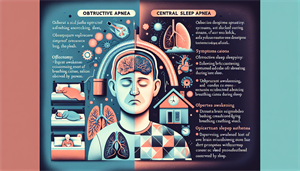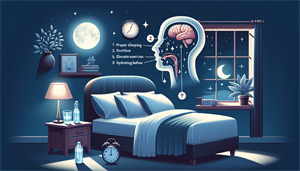
Difference Between Obstructive And Central Sleep Apnea
A good night’s sleep is a luxury that many of us take for granted, but for approximately 22 million Americans, it’s a nightly struggle. Sleep apnea, a condition characterized by repetitive interruptions in breathing during sleep, is a serious sleep disorder that often remains misunderstood.
Understanding the difference between obstructive and central sleep apnea, the two primary classifications of this condition, obstructive sleep apnea (OSA) and central sleep apnea (CSA), present unique challenges in diagnosis and treatment, but distinguishing between them is crucial to improving patients’ health and quality of sleep.
Key Takeaways
-
Obstructive sleep apnea (OSA) is the most common form, caused by physical throat blockage, while central sleep apnea (CSA) is less common and due to brain signal failures affecting breathing muscles.
-
The diagnosis of both OSA and CSA involves identifying specific symptoms and conducting a sleep study, with distinct treatments available including CPAP therapy, lifestyle changes, and medical interventions.
-
Complex Sleep Apnea Syndrome is emerging as a new type characterized by coexisting OSA and CSA, primarily noticed when patients with OSA show CSA symptoms during CPAP treatment.
Unraveling the Two Types of Sleep Apnea
While sleep apnea is a common sleep disorder, the two primary types - central and obstructive sleep apnea - are distinct in their causes and prevalence. Obstructive sleep apnea (OSA), the most prevalent form of sleep apnea, is attributed to the obstruction of throat tissues and throat muscles. On the other hand, central sleep apnea (CSA), a rarer form, is linked to a brain malfunction impacting the signals directed to the breathing-controlling muscles.
Discerning the distinction between these two types of sleep apnea paves the way for effective treatment. Both conditions interrupt normal sleep patterns and, consequently, can negatively impact an individual’s daily life, but their treatments are different. Therefore, correctly identifying the type of sleep apnea is the first step towards improving one’s quality of sleep and overall health.
Obstructive Sleep Apnea Explained
Obstructive Sleep Apnea (OSA) is a condition that affects millions of adults worldwide. In the United States alone, an estimated 39 million adults are affected by this sleep disorder. During sleep, the partial or complete blockage of the throat tissues causes interruptions in the supply of oxygen, leading to the condition. This can result in difficulty breathing and can be a serious health concern.
The obstruction occurs when the throat muscles relax during sleep, causing the airway to narrow or close as you breathe in. As the most common type of sleep apnea, OSA occurs in approximately 3% to 7% of the adult population.
Yet, despite its widespread occurrence, it is frequently undiagnosed. This is because its most noticeable symptom, loud snoring, is often dismissed as a general nuisance rather than a sign of a serious sleep disorder. However, OSA can interfere with reaching deep, restful stages of sleep, thus degrading the overall quality of sleep.
Central Sleep Apnea Unveiled
While OSA is the most common form of sleep apnea, Central Sleep Apnea (CSA) is less common but equally serious. Unlike OSA, which is caused by a blockage in the throat, CSA is characterized by the brain’s inability to transmit appropriate signals to the respiratory muscles during sleep.
This failure of the brain to communicate with the breathing muscles results in periods of interrupted breathing, which is when central sleep apnea occurs. Understanding central sleep apneas is crucial for proper diagnosis and treatment. Diagnosing CSA can be challenging due to its symptom similarity with OSA.


